Content marketing has proved as a good way for B2B companies to generate leads, raise brand awareness, nurture relationships with existing clients and drive sales. These goals are pretty universal. But approaches to attract B2B and B2C audiences have some major differences.

Content Marketing Challenges of B2B Company
According to the research by Content Marketing Institute, only 6% of B2B marketers think that content marketing is very effective for their organizations. But why does it happen? Let’s see the main challenges B2B companies encounter when creating content.
- Attracting B2B audience
- Turning the audience into clients
- Creating engaging content
- Lack of time to create content
- Measuring content effectiveness
- Developing a consistent content strategy
It doesn’t mean a typical B2B company has no chance to join this 6%. To make is easier, review our ideas to achieve the best results with the help of content marketing. Here we go!
How Can Kraftblick Help Your Software Company?

- We build marketing strategies from scratch and fix existing ones. More about that here.
- We provide consultations to company owners, directors, heads of marketing and sales, marketers. This is how we do it.
See you soon 🙂
How to Overcome Content Marketing Hurdles
1. Provide readers with useful information
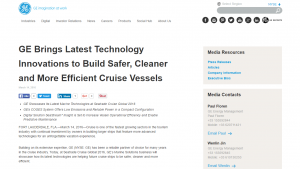
Source – General Electric.
Before getting interested in services or products, first of all, customers need information. They do not care about a company, its products or services. They care about themselves and their needs.
We don’t recommend to dedicate the whole blog to company’s advantages. One major mistake that many B2B companies make is focusing too much on their own business. It’s much easier to grab people’s attention with a helpful article than just advertising services.
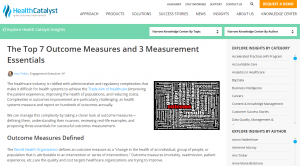
Source – Health Catalyst blog.
Once B2B company gives the audience what they care about, attention and trust will be easily earned. Show customers experience and knowledge in a chosen area. The more evidences of expertise they see the more they trust a company.
Health Catalyst blog is a good example. We can see how Ann Tinker analyzes the most important measures in a healthcare industry, matching her words with her own experience and expertise of the company.
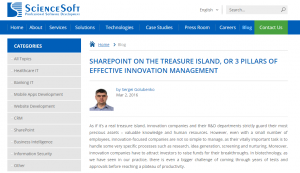
Source – ScienceSoft blog.
Also, we can see a nice example of expertise showcase on ScienceSoft blog. In his article, Sergei Golubenko not only provides readers with the facts but also gives them tips based on ScienceSoft project history.
Let’s look at SiriusDecisions blog. Steve Silver uses his own experience describing the phases of B2B sales process.
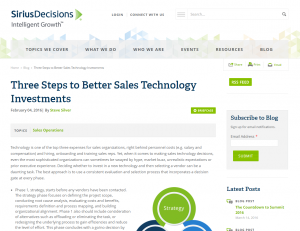
Source – SiriusDecisions blog.
Kacee Johnson said “The single most effective strategy for B2B companies is showing specialization in a target niche. Everyone believes that their company is unique (and most are) but in that they want to feel special, and know that the chosen vendors understand their individual needs”.
If a potential customer can use content for his business, he will be more likely to come back to a company. Provide secret knowledge, or teach them something, or whatever – just be useful.
2. Lead customers through a purchase journey
B2B sales cycles are more complex than B2C. More time is needed to build and nurture relationships with the audience until a person finally makes a decision about a purchase.
Prospects at this stage are investigating and comparing. They look through different websites, weigh the pros and cons, and seek out data and information around how a solution would actually function within their organization.
Promoting a product for B2B audience, mid-funnel content is one of the most important marketing tools. It connects two stages of a purchase process: initial interest and the final sale.
How to create mid-funnel content?
- Give the audience more detailed information about products or services accordingly to the content subject.
- Relay deeper expertise. It’s not enough to only mention the company experience. A reader should understand how the company can be useful for him.
- Foster familiarity with the brand.
- Educate current and potential customers on features of the product. Describe characteristics of the product that will solve customer’s problem.
- Add data, facts, case stories of the company. Talking about challenges, mention own experience, describe the way the company solves these or similar problems.
If you wonder how mid-funnel content may look, let’s see the most common examples.
- E-books give B2B companies the opportunity to request contact information in exchange for a piece of the content, get data about potential customers and use it for further marketing campaigns. This information may include email, name, company name, phone number and so on.

Source – Small Footprint.
- SlideShare presentations is a good way to provide the audience with useful and understandable information.
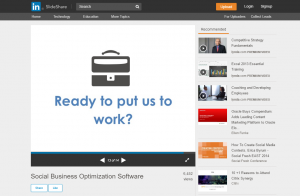
Source – SlideShare.
- To engage with the content, audience needs value. Case studies are here to help.
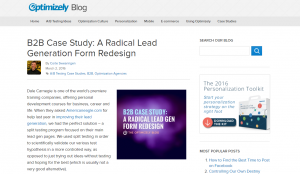
Source – Optimizely blog.
- White papers are meant to help readers understand an issue, solve a problem, or make a decision.
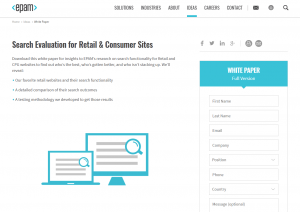
Source – EPAM Systems.
- The main goal of Buyer’s guides & success kits is to provide information to potential customers concerning buying certain services or products.
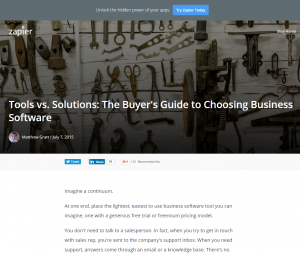
Source – Zapier blog.
- Research papers let B2B companies demonstrate their knowledge in a certain area.
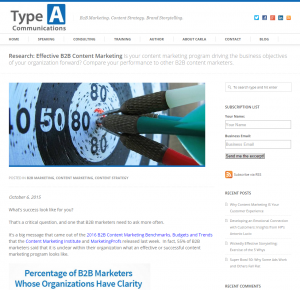
Source – Type A Communications.
3. Show expertise using long form content
Long form content is exactly how it sounds – it is long. There have been many debates about the length of the content that performs well. For B2B area, long content seems to be the most suitable option.
As Danny Wong says “While “snackable content” has been all the rage in agency circles over the past few years, marketers in the B2B tech industry have been discovering something much different: thoughtful long form content is actually your best chance to go viral and make an impact”.
We can tell from the stats below that the longer the content, the more shares it can get. 3,000 – 10.000 word pieces content may get twice more shares than a small text with less than 1,000 words.
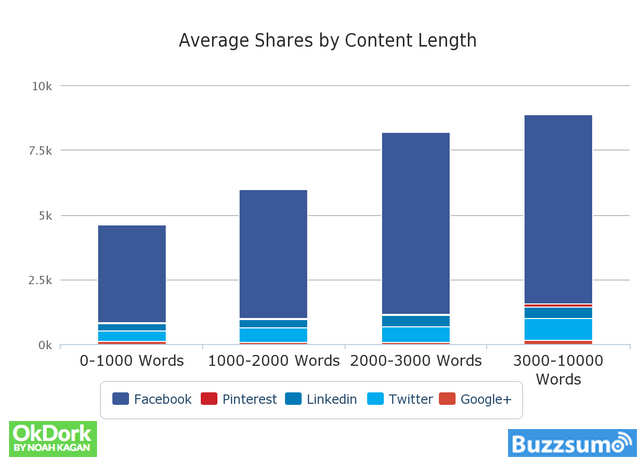
Source – OkDork.
Let’s see good examples of long form content:
- Copyblogger. Demian Farnworth compares pros and cons of both content marketing and advertising, using quotes, researches, videos, etc.
- Belitsoft. Alexander Kom describes the whole process of hiring a programmer using long form content.
- Segue Technologies. Mark Shapiro describes the challenges of Applying Agile Methodologies in Non-Agile Contractual Scenarios and explains the reasons for them.
But it’s not just a matter of length. To capture audience’s attention and truly drive purchase decisions, B2B companies need content of a high quality.
4. Strive for quality, not for frequency
Content quality is more than just spelling and grammar. It’s also determined by other critically important, and yet often overlooked factors like a style, tone, and clarity, which are just as essential to engage the audience, build trust, and create a better overall customer experience.
If the quality of the content is bad, people won’t expect good work from the company.
In such a competitive area like B2B, it is not enough to simply produce “more” content. Now is the time to produce killer content that will leave all the competitors far behind.
What constitutes “high quality” content? Let’s find out how to make content worth noticing.
- Choose the main idea of a content piece and focus on it.
- Do not use trivial topics, add some novelty to the content.
- Choose a subject that is relevant to the business.
- Prove your words: provide examples, resources, researches, stats and so on.
- Make a clear message that will be easily understood by the audience.
5. Emphasize value
B2B companies are often missing the key element that buyers care about: how their company can benefit from the product.
Imagine the situation: a CEO is searching for banking software for his business. He sees the article “How to choose a banking software for your company”. He opens it because the title correlates with his query.
After reading the article, he gets a complete idea of software he really needs and notices that the company, whose blog he is reading, develops that same banking software. Would he like to consider their services? Or, at least, get in touch with the company?

6. Remember: there is still a person behind the business
Never forget a simple idea: content still targets real people. Audience shouldn’t be taken for granted.
Even if a company targets other companies, there are people behind these businesses.
General Rules for Creating Content
B2B company shouldn’t forget about universal rules for creating content.
- mission of the company

Source – IBM blog.
A good content marketing campaign starts by associating the company with the products and services it offers on the market.
It should reflect the company’s mission, otherwise, it will waste all the efforts to reach out to other businesses.
- examples and case stories
When an article is filled with author’s own experience, case stories, statistics, it will give a reader the opportunity to immerse in the topic and comprehend it. Real-life examples catch attention and are funny to read.
- visual content
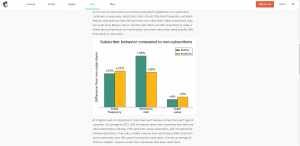
Source – MailChimp blog.
Customers are human beings and visual by nature. According to Brian Honigman, “Over thirty percent of our brain-power is dedicated to processing visual input and our optical abilities go far beyond simply “seeing” what is in front of us”.
Our brain absorbs images much faster than text. Even without reading the text we can look at the illustrations and get the idea of it.
- engagement
The best way to understand the audience is by engaging with it. Reply to comments, ask for feedback, and let them tell what they want and what they like, instead of trying to figure it out all alone.
- documented content marketing strategy
It should define the target audience of the business, content types and topics matching interests of chosen audience and company’s marketing goals. It may also include additional parameters depending on a business purpose.
- measurement and analysis
Some marketers are so stuck in the process of creating content that they forget to stop and evaluate the results of their efforts.
According to content marketing spotlight report by Spiceworks, the most popular metrics to measure content marketing success are:

Source – Spiceworks.
In Summary
B2B and B2C audiences are completely different. The approach to creating content should be different as well.
For corporate customers, purchasing decisions are grounded in reason, and content should be valuable to show the features of the product. While there is a chance to catch a B2C customer in a spontaneous “purchase” kind of mood, companies tend to be rather more systematic about making a purchase.
For companies in a B2B area, mid-funnel content is the way to lead a potential customer through the process of making a decision, helping him evaluate the product and develop an affinity for it.
There are many opinions about the content volume, but statistics and researches demonstrate that in a B2B area long form content brings much more significant results.
Build relationships with the audience and treat it like a little baby: continue to surprise them and keep curious about every step. Make the journey exciting and groovy for both sides.